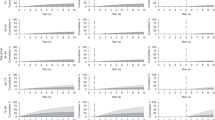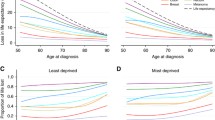Abstract
Purpose
To evaluate changes in cancer mortality burden over time by assessing temporal trends in life expectation for Australian residents diagnosed with cancer.
Methods
The study cohort consisted of all people diagnosed with cancer in the period 1990–2000 and aged 15–89 years (n = 1,275,978), with mortality follow-up to 31 December 2010. Flexible parametric survival models incorporating background age–sex–year-specific population mortality rates were applied to generate the observed survival curves for all cancers combined and selected major cancer types. Predicted values of loss of life expectancy (LOLE) in years were generated and then averaged across calendar year and age group (15–49, 50–69 and 70–89 years) or spread of disease (localized, regional, distant, unknown).
Results
The greatest LOLE burden was for lung cancer (14.3 years per diagnosis) and lowest for melanoma (2.5 years). There was a significant decrease in LOLE over time (−0.13 LOLE per year) for all cancers combined. Decreases were also observed for female breast cancer (−0.21), prostate cancer (−0.17), colorectal cancer (−0.08), melanoma (−0.07) and stomach cancer (−0.02), with slight increases for lung cancer (+0.04). When restricted to the sub-cohort from New South Wales with spread of disease information, these decreases in LOLE were primarily among cancers categorized as localized or regional spread at diagnosis.
Conclusions
In Australia, persons diagnosed with cancer have a steadily improving outlook that exceeds that expected by general improvement in population life expectancy. The overall improvement is observed in persons with localized or regional cancers but not in those with advanced cancers, findings which encourage earlier diagnosis.


Similar content being viewed by others
References
Brustugun OT, Moller B, Helland A (2014) Years of life lost as a measure of cancer burden on a national level. Br J Cancer 111:1014–1020
Soneji S, Beltran-Sanchez H, Sox HC (2014) Assessing progress in reducing the burden of cancer mortality, 1985–2005. J Clin Oncol 32:444–448
van Kruijsdijk RC, van der Graaf Y, Koffijberg H et al (2016) Cause-specific mortality and years of life lost in patients with different manifestations of vascular disease. Eur J Prev Cardiol 23:160–169
Ibayashi H, Pham TM, Fu**o Y et al (2011) Estimation of premature mortality from oral cancer in Japan, 1995 and 2005. Cancer Epidemiol 35:342–344
Andersson TM, Dickman PW, Eloranta S, Lambe M, Lambert PC (2013) Estimating the loss in expectation of life due to cancer using flexible parametric survival models. Stat Med 32:5286–5300
Baade P, Youlden D, Andersson TM et al (2015) Estimating the change in life expectancy after a diagnosis of cancer among the Australian population. BMJ Open 5:e006740
Royston P, Parmar MK (2002) Flexible parametric proportional-hazards and proportional-odds models for censored survival data, with application to prognostic modelling and estimation of treatment effects. Stat Med 21:2175–2197
Hwang JS, Wang JD (1999) Monte Carlo estimation of extrapolation of quality-adjusted survival for follow-up studies. Stat Med 18:1627–1640
Hwang JS, Wang JD (2004) Integrating health profile with survival for quality of life assessment. Qual Life Res 13:1–10; discussion 1–4
Liu PH, Wang JD, Keating NL (2013) Expected years of life lost for six potentially preventable cancers in the United States. Prev Med 56:309–313
AIHW (2015) Life expectancy. Australian Institute of Health and Welfare. (http://www.aihw.gov.au/deaths/life-expectancy/) Accessed 7th Apr 2015
AIHW (2013) Cancer in Australia: actual incidence data from 1991 to 2009 and mortality data from 1991 to 2010 with projections to 2012. Asia Pac J Clin Oncol 9:199–213
AIHW, AACR (2012) Cancer in Australia: an overview, 2012. Cancer series 74. Cat. No. CAN 70. Australian Institute of Health and Welfare (AIHW) and Australasian Association of Cancer Registries (AACR), Canberra
Baade PD, Youlden DR, Valery PC et al (2010) Trends in incidence of childhood cancer in Australia, 1983–2006. Br J Cancer 102:620–626
Baade PD, Youlden DR, Chambers SK (2011) When do I know I am cured? Using conditional estimates to provide better information about cancer survival prospects. Med J Aust 194:73–77
Lambert PC, Royston P (2009) Further development of flexible parametric models for survival analysis. Stata J 9:265–290
Royston P, Lambert PC (2011) Flexible parametric survival analysis using stata: beyond the cox model. Stata Press, College Station
Van Ewijk RJ, Schwentner L, Wockel A et al (2013) Trends in patient characteristics, treatment and survival in breast cancer in a non-selected retrospective clinical cohort study of 2600 patients. Arch Gynecol Obstet 287:103–110
Roder D, Karapetis CS, Wattchow D et al (2015) Colorectal cancer treatment and survival: the experience of major public hospitals in South Australia over three decades. Asian Pac J Cancer Prev APJCP 16:2431–2440
Allemani C, Rachet B, Weir HK et al (2013) Colorectal cancer survival in the USA and Europe: a CONCORD high-resolution study. BMJ Open 3:e003055
Rosa F, Alfieri S, Tortorelli AP, Fiorillo C, Costamagna G, Doglietto GB (2014) Trends in clinical features, postoperative outcomes, and long-term survival for gastric cancer: a western experience with 1278 patients over 30 years. World J Surg Oncol 12:217
Wei EK, Wolin KY, Colditz GA (2010) Time course of risk factors in cancer etiology and progression. J Clin Oncol 28:4052–4057
Parkin E, O’Reilly DA, Sherlock DJ, Manoharan P, Renehan AG (2014) Excess adiposity and survival in patients with colorectal cancer: a systematic review. Obes Rev 15:434–451
Allott EH, Masko EM, Freedland SJ (2013) Obesity and prostate cancer: weighing the evidence. Eur Urol 63:800–809
Goodwin PJ (2010) Commentary on: “effect of obesity on survival in women with breast cancer: systematic review and meta-analysis” (Melinda Protani, Michael Coory, Jennifer H. Martin). Breast Cancer Res Treat 123:637–640
Protani M, Coory M, Martin JH (2010) Effect of obesity on survival of women with breast cancer: systematic review and meta-analysis. Breast Cancer Res Treat 123:627–635
Allemani C, Weir HK, Carreira H et al (2015) Global surveillance of cancer survival 1995–2009: analysis of individual data for 25,676,887 patients from 279 population-based registries in 67 countries (CONCORD-2). Lancet 385:977–1010
Moyer VA, Force USPST (2014) Screening for lung cancer: U.S. preventive services task force recommendation statement. Ann Intern Med 160:330–338
Green AC, Baade P, Coory M, Aitken JF, Smithers M (2012) Population-based 20-year survival among people diagnosed with thin melanomas in Queensland, Australia. J Clin Oncol 30:1462–1467
Whiteman DC, Baade PD, Olsen CM (2015) More people die from thin melanomas (1 mm) than from thick melanomas (>4 mm) in Queensland, Australia. J Investig Dermatol 135:1190–1193
Acknowledgments
We thank the staff of the State and Territory Cancer Registries and the Australian Cancer database, from which these study data were obtained.
Funding
Philippa Youl is funded by a National Health and Medical Research Council Early Career Fellowship (#1054038). The funding body had no input into the study design, the collection, analysis and interpretation of data, the writing of the report or the decision to submit the article for publication.
Author information
Authors and Affiliations
Corresponding author
Ethics declarations
Conflict of interest
The authors report no conflict of interest.
Ethical approval
Approval for the use of the anonymized data was provided by all of the individual State and Territory Cancer Registries through the Australian Institute of Health and Welfare (AIHW), with the exception of the Australian Capital Territory (ACT).
Informed consent
Since no individuals were identified nor able to be contacted, informed consent was not required.
Electronic supplementary material
Below is the link to the electronic supplementary material.
Rights and permissions
About this article
Cite this article
Baade, P.D., Youlden, D.R., Andersson, T.M. et al. Temporal changes in loss of life expectancy due to cancer in Australia: a flexible parametric approach. Cancer Causes Control 27, 955–964 (2016). https://doi.org/10.1007/s10552-016-0762-1
Received:
Accepted:
Published:
Issue Date:
DOI: https://doi.org/10.1007/s10552-016-0762-1




